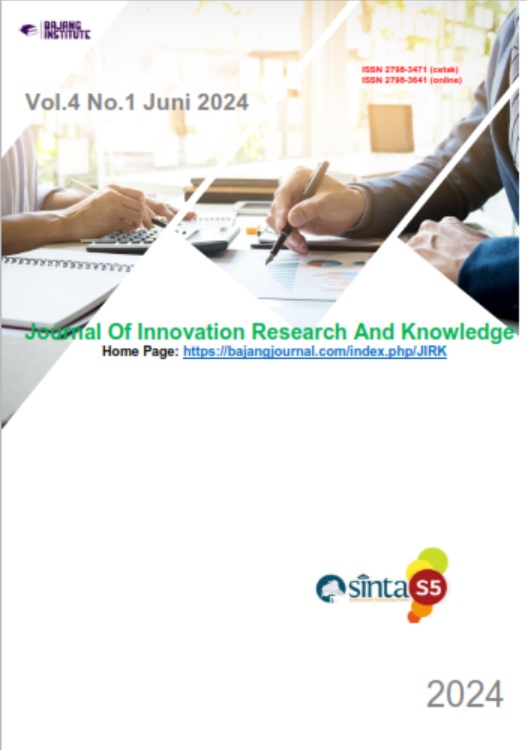EVALUASI MANAJEMEN CENTRAL STERILLE SUPPLY DEPARTEMENT DI RUMAH SAKIT
DOI:
https://doi.org/10.53625/jirk.v4i1.7824Keywords:
Management, Sterilization, CSSD, HospitalAbstract
Background : In the era of globalization and decentralization, hospitals must be ready to face challenges and changes. The number of nosocomial infections continues to increase, reaching around 9% (variation 3-21%) or >1.4 million inpatients in hospitals throughout the world. How to minimize the risk The occurrence of infections in hospitals and other health service facilities requires Infection Prevention and Control (PPI) to be implemented, namely activities that include planning, implementation, coaching, education and training, as well as monitoring and. CSSD management in hospitals which includes planning, organizing, implementing, monitoring and evaluating CSSD management is really needed by a hospital because without management achieving its goals will be more difficult. The problems in the CSSD Unit are the lack of human resources and inadequate CSSD facilities. Methods : Research uses a qualitative descriptive type. Data collection uses interview techniques and observation. Where the subjects were taken as many as 3 people. Results : The results of the research show that the planning and organization of the CSSD has been well planned, the implementation of the CSSD has gone well and is in accordance with the CSSD guidelines issued by the Ministry of Health, however there are still duplicate jobs. supervision has gone well, and evaluation has gone well in accordance with evaluation theory. Conclusion : the planning and organization of CSSD has been well planned in accordance with planning theory, and the organization refers to the organizational structure issued by the Ministry of Health. The implementation of CSSD has been going well and in accordance with the CSSD guidelines issued by the Ministry of Health, however there is still work overlap. Supervision and evaluation have been running well according to the Formative and Summative evaluation types
References
Departemen Kesehatan Republik Indonesia Tahun 2009 tentang Pedoman Instalasi Pusat Sterilisasi Di Rumah
Menteri Kesehatan. (2004). Persayaratan Kesehatan Lingkungan Rumah Sakit . Jakarta : Menteri Kesehatan. 2.
Adisasmito. (2008).Kesiapan rumah Sakit Dalam Menghadapi Globallisasi. Jakarta:Universitas Indonesia.
Undang-Undang Republik Indonesia No 44 Tahun 2009, Tentang Rumah Sakit, 8 Juli 2009, Lembaran Negara Republik Indonesia Tahun 2009 Nomor 4301,a Jakarta 3.
Herlambang, S.,Murwani, A.2012.Cara Mudah Memahami Manajemen Kesehatan dan Rumah Sakit. Yogyakarta: Gosyen publishing
Wijaya, A., Permana, I. 2016. Evaluasi Pengelolaan Instalasi Pusat Sterilisasi RS PKU Muhammadiyah Yogyakarta Unit II.Jurnal Asosiasi Dosen Muhammmadiyah Magister Administrasi Rumah Sakit Vol. 02, No. 02. Hal. 1-9
Awaludin, awaludin; ahid mudayana, ahmad. Manajemen central sterile supply department unit sterilisasi sentral di RSU PKU Muhammadiyah Bantul Yogyakarta. Berita Kedokteran Masyarakat, 2019, 35.4: 8-5.
Mustika, irma febri. Evaluasi manajemen central sterile supply departement (cssd) di rumah sakit. Jurnal medika indonesia, 2020, 1.2: 1-5.
Kartikasari, dhian; wardhani, Viera. Should the Central Sterile Supply Department in Every Hospital?. Journal: JMMR (Jurnal Medicoeticolegal dan Manajemen Rumah Sakit), 2020, 9.1: 61-75.
Purwanti, Dwi Indah, et al. Analisis Perhitungan Jumlah Kebutuhan SDM Menggunakan Metode Workload Indicators of Staffing Need (WISN) di Instalasi Central Sterile Supply Department (CSSD) Rumah Sakit Swasta. International Journal of Healthcare Research, 2023, 6.2.













